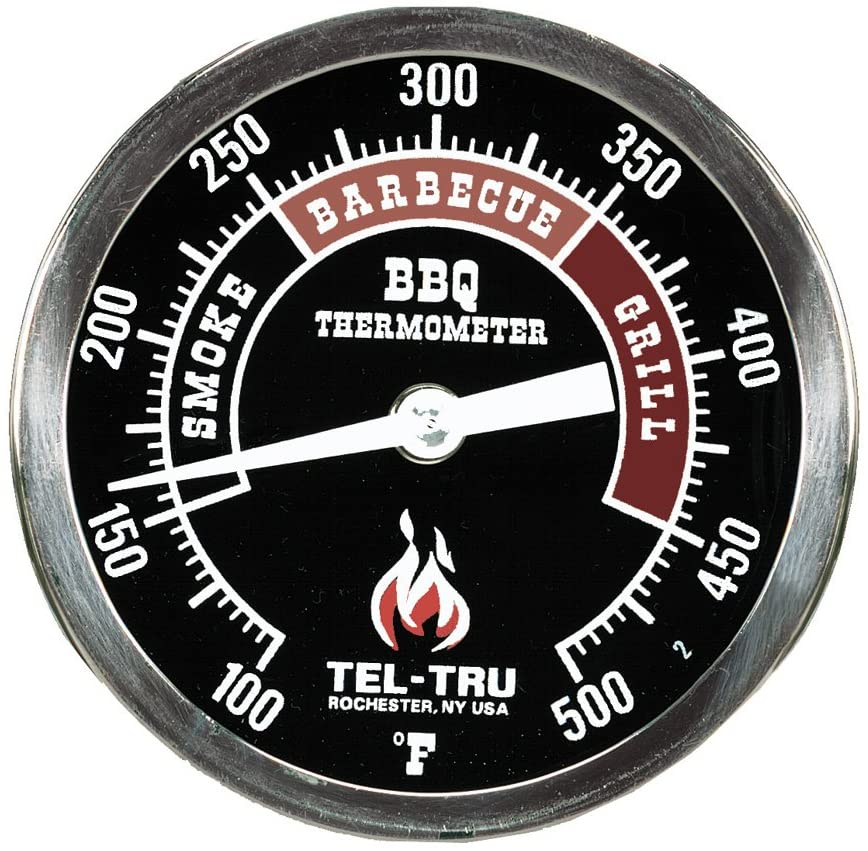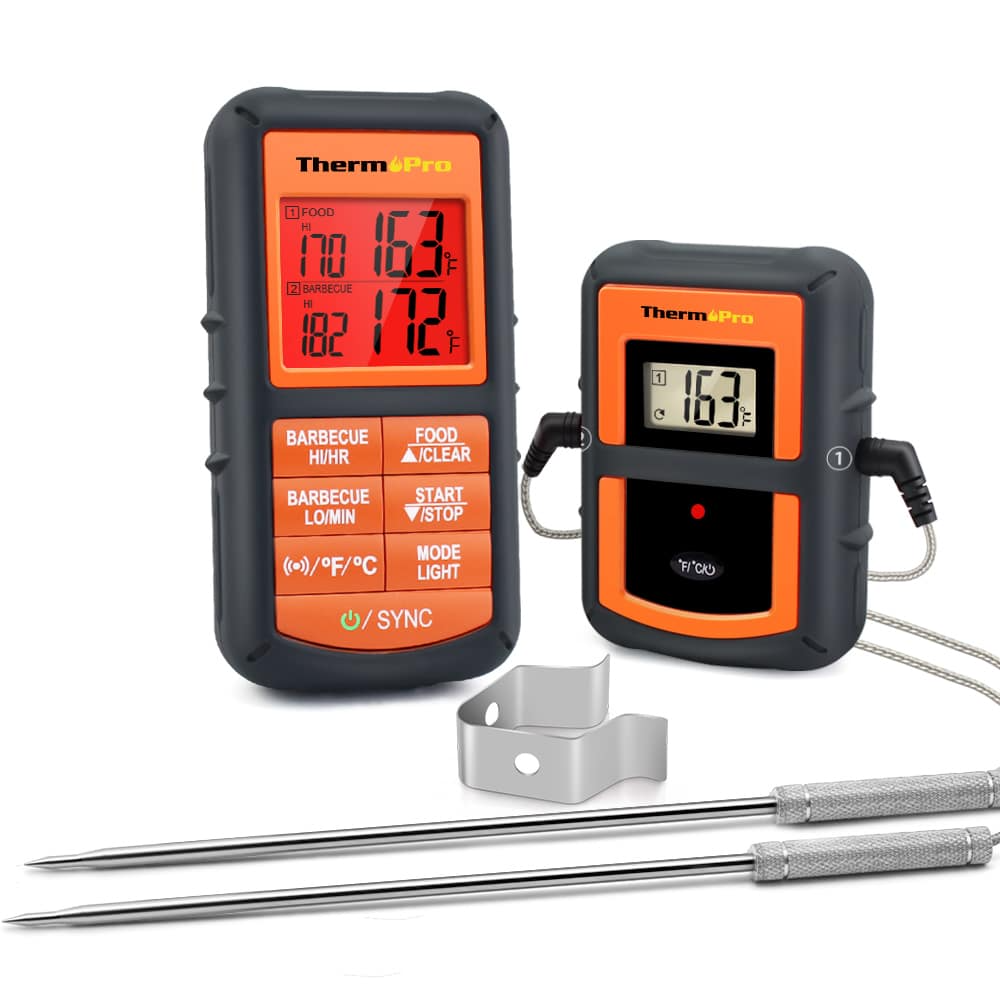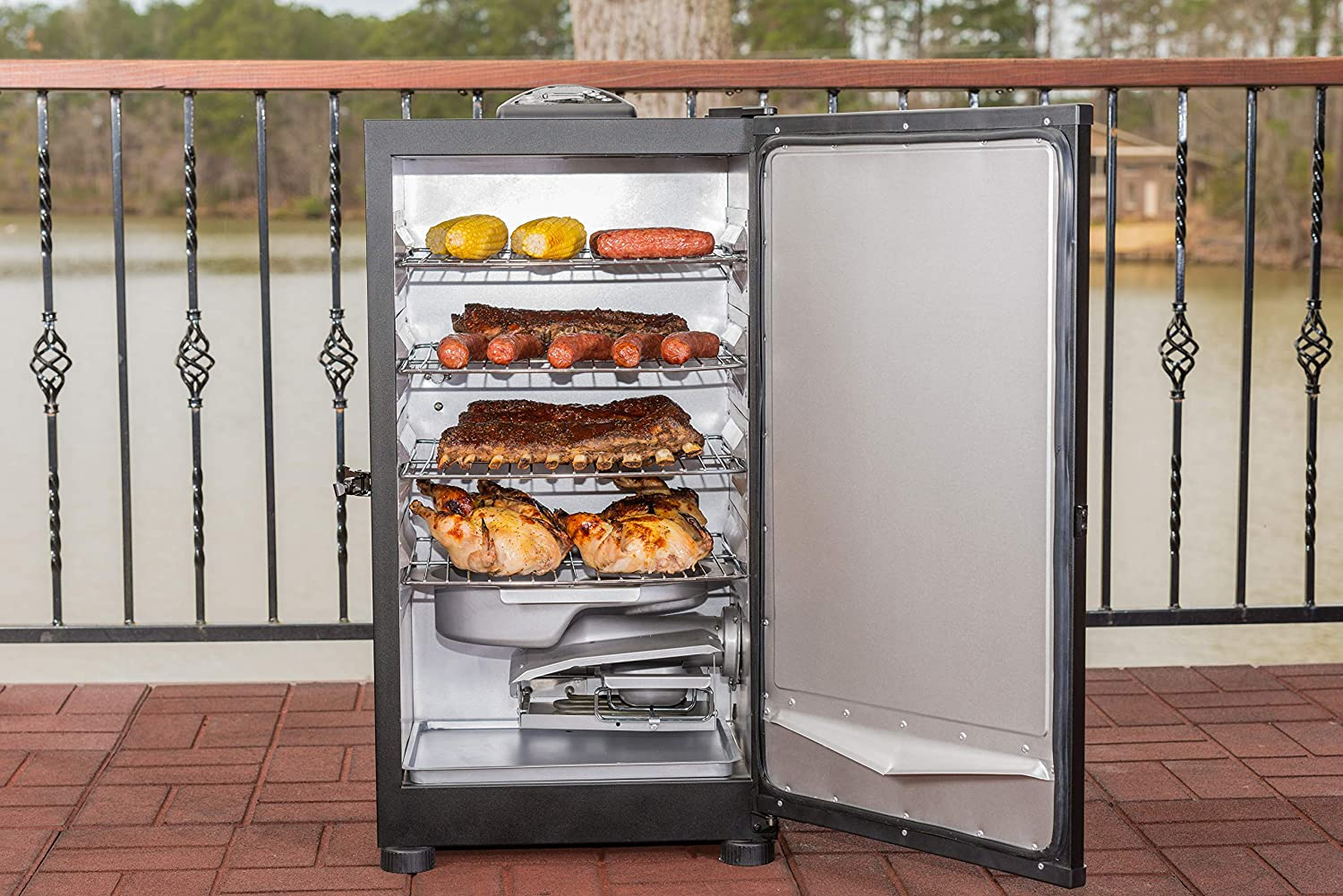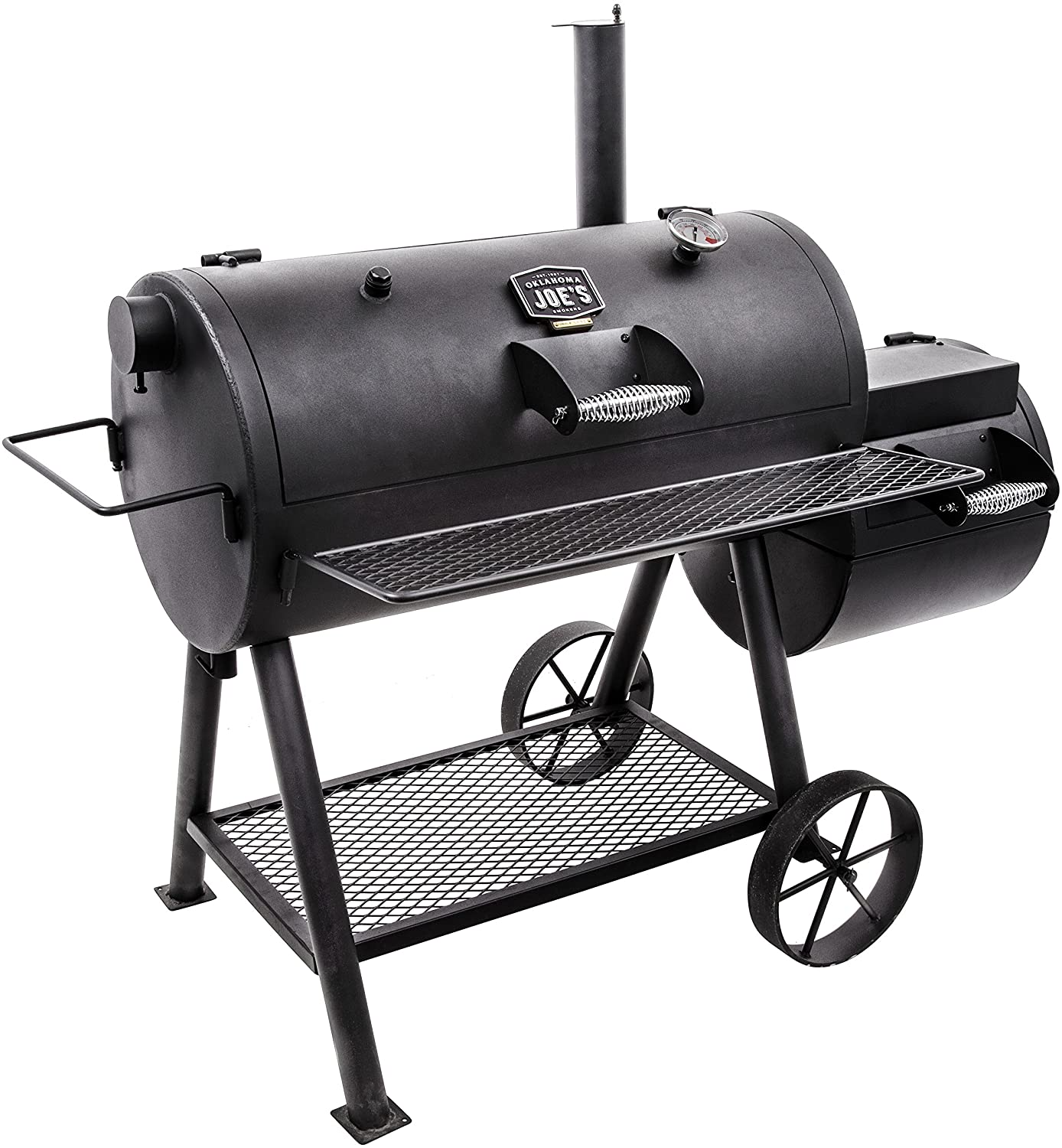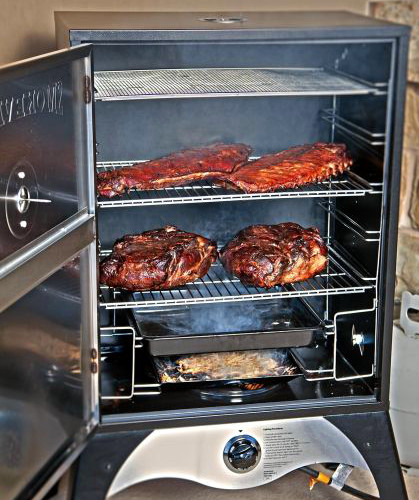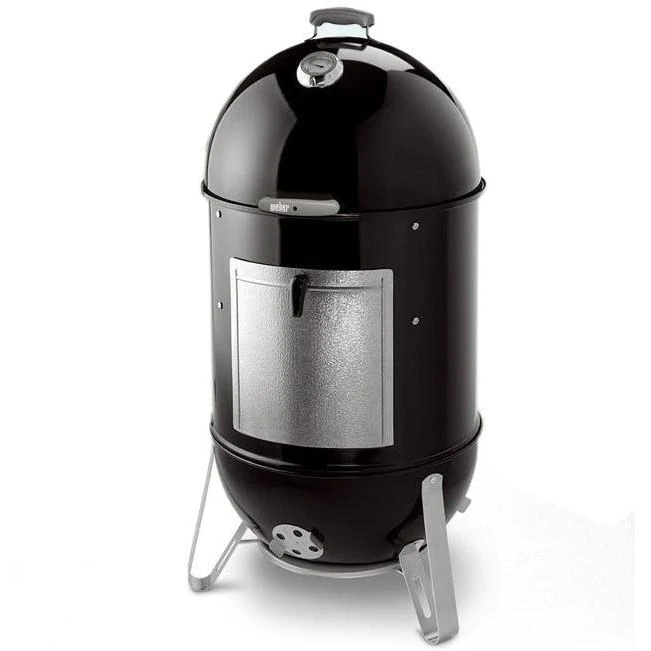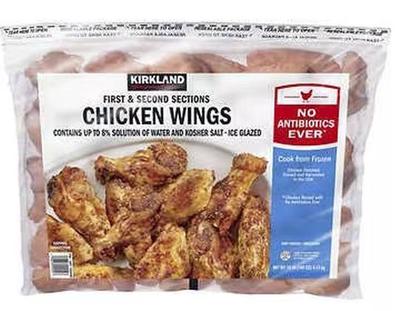Barbecue Smokers. Revealing Must Know Information Before You Buy The Wrong Meat Smoker.
Looking for great information on barbecue smokers?
Want to make sure you get the perfect meat smoker so you can be in barbecue nirvana?
Then you've come to the right place!
A good, reliable barbecue smoker is an essential tool for making delicious, juicy, lipsmackin' barbecue.
Let me explain why;
The basic concept of barbecue is simple; Take a tough cut of meat. Season it so it's nice and spicy. Cook it over hardwood smoke, at a low temperature, somewhere around 250°F, until it becomes tender and delicious.
The challenge comes in maintaining that low temperature. Difficult to do with most outdoor cooking equipment like grills, because they are designed to grill, which is a high heat cooking method. This is where a good, reliable barbecue smoker or "barbecue pit" becomes essential.
Temperature Control
The temperature inside your barbecue smoker is maintained by keeping the food far away from the heat source...
While a fire burns very hot, if you keep it far enough away from the food, by the time the heat reaches the food, it has cooled down enough to give you the correct temperature.
This is accomplished by two basic designs; You either put your fire far below the food or off to the side. A smoker that has the heat source off to the side, instead of below the food, is known as an "offset smoker".
Barbecue Thermometers
Critical Information About Barbecue Smokers - How do you know if the cooking chamber of your smoker is at the ideal temperature to make lipsmackin' barbecue? You need a good, reliable, accurate thermometer.
Most smokers come with one built into them. Make sure yours has numbers on it. Don't use one that has readings like; cold, warm, ideal, hot, etc... If it does...replace it with a good, reliable, accurate thermometer with numerical temperature readings like the one pictured below.
Also, mount it so the probe is close to the cooking grate where the food will be. A thermometer mounted on the top of the smoker lid is pretty much useless. You need to know the temperature at the cooking grate.
You can also use an oven thermometer inside your pit. Unfortunately, when you lift the lid to check the temperature, you lose precious heat which lengthens your cook time.
I personally love a remote thermometer. It has a probe that you place inside your cooker on the grate. It has a digital display and sends the temp to a monitor that you carry around. You can watch the game and see the temperature of your barbecue pit at the same time!
Types of Barbecue Smokers.
Vertical Barbecue Smokers
A vertical barbecue smoker, or upright smoker, is a smoker that is higher than it is wide.
See the picture above.
They usually have racks inside of them, like your oven, and the food to be cooked is placed on these racks. In fact, a lot of these look like ovens. Some are even referred to as "wood burning ovens". Usually these racks are stationary, but some models have racks that rotate the food to help it cook evenly.
They can be as simple as a barrel or two, with racks to hold the food and a water pan to add moisture and shield the food from the heat, to very high-tech boxes with high grade steel and digital controls. Sizes range from very small, about 15 inches across, to huge barbecue pits used in restaurants that are large enough to cook several small hogs at a time. They can range in price from about $70.00 to many thousands of dollars.
Horizontal Barbecue Smokers
Horizontal barbecue smokers, often referred to as "offset smokers", are merely barbecue pits, that are wider than they are high.
See the picture above.
Most backyard models have one large rack and a smaller rack. Larger models may have several racks to place your barbecue on.
They can be very simple and relatively small, though even the smallest models usually have more cooking area than your average grill. Of course you can get very large horizontal smokers big enough to smoke several hogs at a time.
Designs may be very simple; two barrels fastened at the ends, with a cutout where they meet, to take the smoke and heat from the fire box to the cooking chamber. More sophisticated and high tech models are available as well, with automated controls and state of the art materials. As well as a range of innovative design features
They
range in price from about $150.00 and up.
Got a Barbecue Smoker You'd Like to Tell Us About?
Do you have a smoker that you love? Maybe one you don't like so much? Tell us about it here!
What to Consider When Purchasing a Barbecue Smoker.
When you are purchasing a tool, which is what a barbecue pit or smoker really is, you need to have your end results in mind. This will ensure that you have the right piece of equipment to get the job done the way you want it done, and the way you want to do it.
There are several factors to keep in mind;
- What you will be cooking?
- How many people you will be cooking for?
- Ease of use.
- Fuel that you will be using.
- Price.
What Size Barbecue Smoker Do You Need?
The size of your barbecue pit is one of the most important factors to consider and this depends on two factors; what you want to cook and how many people you are cooking for.
First, what are you cooking?
If you want to cook whole hogs, a small vertical smoker is not going to work for you. Say you're a rib fanatic. A small vertical smoker may not work for you either, because a rack of ribs will not fit into the smoker without being wrapped around a rib rack or being cut to fit.
On the other hand, if you live in an area with limited space, a small vertical smoker may be perfect for you.
I have a Camp Chef Smoke Vault 24".
You can see it in action on my barbecue turkey page.
It's a vertical smoker, but it's 24" wide. I've cooked large slabs of ribs, pork butts, beef brisket and whole turkeys in it.
If you're looking for a vertical smoker that is easy to use and big enough for ribs, pork shoulder, briskets and turkeys, check out the Camp Chef Smoke Vault 24".
Next thing to consider is; how many people are you cooking for?
If you're cooking for just a few people, then your barbecue pit doesn't need to be huge. However, if you like to host parties or you have a large family, you need a bigger smoker.
It's always better to have a bigger pit, than a smaller one. Barbecue takes a long time. It takes just as long to cook one pork butt, as it does to load up your pit and cook a few more. This also uses your fuel more efficiently. For example; if you're using an offset smoker that burns charcoal, you're going to use a bag or two, maybe more, during your cook. Using 15-20 pounds of charcoal to barbecue one chicken makes for an expensive meal!
I think it's best to load up your barbecue pit, invite your friends and family over and have a great time. You can always save the leftovers, if there are any...
Note: When using an offset smoker, use wood as your heat source. Using wood instead of charcoal gives you a hotter, more consistent heat source.
What Barbecue Smoker Fits Your Personality?
You may be saying to yourself...Self...What is this guy talking about?!?
This is where ease of use comes in. You want to select the pit that matches your cooking style or personality. So you should ask yourself a few questions.
- Are you a "hands on" kind of person?
Do you like to be involved in the cooking process, or do you like to "set it and forget it"? You can choose a unit that is manual and burns logs or charcoal. This requires that the fire be tended periodically.
Depending on the model you have, this will have to be done every several hours to every hour, especially when you are first learning how to use your new toy. If you'd like to spend your time doing something other than tending your fire, an automated unit might be more to your liking.
- Are you a "high tech" kind of person?
Do you like gadgets and devices or are you more of a "traditionalist"?
Barbecue pits come in all shapes and sizes, colors and costs. But there's really only two types; Thermostatically controlled automatic pits that burn wood "pellets", "bisquettes", wood chips or chunks and manual pits that burn wood or charcoal.
The manual barbecue pits and the pit-masters who use them are referred to as "stick burners". Again this has to do a lot with your personality and personal preference. It's kind of like people who grill; some prefer charcoal and some prefer gas.
If you like high tech equipment, than you'll love an automated unit. Some of these smokers are fully automated to control temperature and smoke. Others control temperature but you have to add wood for smoke. Many have digital readouts, so you can monitor everything precisely, and all the other bells and whistles that you would ever need.
Now, if you don't like bells and whistles, and you don't think anything digital or high tech should be within 50 feet of a barbecue pit, then this type of rig would not be for you.
Something You Should Know About Barbecue Smokers; There are devices called "Barbecue Temperature Controllers". They monitor the temperature inside your pit and regulate it to whatever you set it at, within the device's range.
These controls work by using a sensor, inside your smoker, that is attached to a fan. The fan is mounted to the inlet of your smoker. This fan blows air into the pit to help regulate the temperature.
Essentially, it monitors the temperature and stokes the fire for you!
It's not fully automated, because you still have to add fuel to keep your fire going, (fully automated units add fuel for you.) but it does make temperature control much easier.
So if you like the idea of a wood or charcoal burning pit and digital temperature controls, then you definitely want to take a look at them.
Critical Information You Need Before Purchasing Any Barbecue Smoker.
Barbecue smokers range considerably in price. From less than a hundred dollars to many thousands of dollars.
Let me explain why;
A barbecue smoker is like any other durable good and price is dictated by several factors;
- Amount of materials used to make the product.
- The quality of those materials.
- The skill of the manufacturer or craftsman that makes the product.
- The reputation of the product or company.
Amount of Materials
The amount of materials used to make a barbecue smoker will, of course, naturally have an influence on the price. It takes less steel to make a small vertical smoker that sits on your apartment balcony, than it does to make a large offset smoker that's used in competition and hauled behind your pickup truck.
More steel costs more than less
steel.
Quality of Materials
The quality of materials is second only to the skill of the producer of your barbecue smoker. This has a huge influence on ease of use. When you have a properly designed barbecue smoker, that is well built using quality materials, you get superior results.
But rest assured, it takes more than a nice barbecue rig to make lipsmackin' barbecue. There is a little skill involved. But nothing you can't master...
(For more on that, check out the barbecue tips page and the recipes page at Barbecue-Know-How.com.)
The higher priced smokers are generally manufactured with a higher gauge steel, usually 1/4" plate steel. This steel is thicker than the steel used in less expensive barbecue smokers. This thicker steel helps to retain the heat in your barbecue pit.
This makes temperature control much easier and helps to prevent fluctuations in temperature. This is because the heat is being retained in your smoker instead of escaping at an alarming rate.
Heat retention is critical in barbecue because barbecue has to be cooked at a low, steady temperature.
Some of these fine cookers even have insulated fire boxes to use your heat and fuel more efficiently. This drastically cuts down the time required for tending the fire and saves you a bundle in fuel.
The components of the higher quality smokers are also of better quality. Things like sturdy, accurate thermometers with numerical readings. The electronic controls used to set the temperature, if so equipped, will be more accurate with less tolerances in temperature fluctuations.
The Skill of The Craftsman
This is the most critical aspect when purchasing a barbecue smoker.
You can have tons of high quality materials, but if the person building your smoker doesn't know what he's doing, it really doesn't do you much good.
The skill of the craftsman is more than knowing how to put something together...
The design is critical. Good manufacturers of smokers know how to design a smoker that cooks well and is easy to use. They use the finest materials and implement designs with things like a baffle plate, to make a "reverse flow" smoker.
This plate is placed at the inlet of the smoker, near the fire box, and runs underneath the cooking area. It's designed to draw smoke in from one end of the smoker, underneath the food being cooked, and then into the cooking chamber. The smoke is then drawn out of the smoker through the smoke stack that is strategically located at the same end as the fire box is. This results in a much "cleaner" smoke, more smoke flavor and a more consistent heat throughout the cooking chamber.
The location and size of the dampers of your barbecue smoker are also very important. They have to be located on the smoker so that smoke flows properly through your smoker. If the smoke stays in the cooking chamber too long, your barbecue will taste like soot. If the smoke flows to quickly, you won't have much smoke flavor and you will have to use more fuel than you need to.
After the design comes the building. One of the best features of a well built smoker is that all the pieces fit together well. All the places where the pieces come together, the doors and the baffles, fit together snugly and are well sealed. There is no gap where the smoke stack enters the smoker body. This keeps precious smoke and heat inside your barbecue pit, where it belongs! This makes maintaining and stabilizing the temperature much easier. It also helps you use your fuel more efficiently.
These finer barbecue pits also use a minimum amount of nuts and bolts. Look for a smoker that has been welded together. The welds should be nice, clean and even looking. All steel pieces should be ground down so there are no sharp edges.
Also avoid barbecue pits that have wooden handles. These handles expand and contract with the heat of your cooker and are often exposed to the elements. Not good conditions for wood. They will crack and fall apart after a few seasons.
If your smoker has wheels make sure they are sturdy and tough.
Make sure the barbecue pit is sturdy. Grab one end of it (the cooking chamber end) and try to wiggle it back and forth. It shouldn't feel flimsy and move around, it should stay put and feel firm.
If its on a trailer, make sure it is constructed by a licensed trailer manufacturer. Your rig should come with a Certificate of Origin and a Vehicle Identification Number. This is so you can register it and legally haul it on the road.
The Reputation of The Product
The reputation of a product does play a factor in the price of that product; Sometimes it's justified and sometimes it's not.
You don't always have to spend the most to get the best. You can purchase many products that are just as good, or better, than the more expensive ones.
If you know what to look for...
We're not talking about price or reputation. We're talking about value.
Don't you want to...
- Get the most you can for that hard earned money you're gonna spend?
- Find a barbecue you'll enjoy using?
- Know that you'll have a barbecue smoker that'll last for years to come?
That's what this page is all about;
Helping you discover what you need to know before purchasing a barbecue smoker.
If you know what to look for in a quality barbecue pit you won't need to make your decision based solely on a companies reputation or price. You can make a well informed, educated choice based on quality, value and what you're really looking for in a barbecue smoker
You can do that by...
- Using the helpful information on this page.
- Reading reviews about the product.
- Visiting forums that discuss the product.
- Checking out the manufacturer. Some companies deserve a good reputation. If the company has been around for years and has rave reviews, you should have no problems. Make sure they offer a guarantee and a warranty.
- In essence, find out all you can before making your investment.
Next, let's talk about an important subject regarding barbecues...
What Fuel Should You Use In Your Smoker?
Here's something that many people rarely think about when looking at smokers...
What fuel does the smoker that you're about to purchase use?
What you should consider is:
- How much does it cost?
- How readily available is it?
By fuel I mean, what you are going to use to cook and flavor your food.
One of the main components in barbecue flavor is smoke. This smoke comes from wood. But not just any wood, it must be hardwood. Soft woods, like pine and cedar, contain resin, which makes your barbecue bitter and foul tasting.
Wood Used for Barbecue
Different
types of wood, of course, impart different flavors to the food that
you're cooking. Below is a list of the types of wood commonly used in
barbecue.
- Alder - Imparts a mild flavor. Most commonly used for smoked salmon. Works wonders with most fish.
- Apple - Mild, sweet and fruity flavor. Good for blending with other woods. Great for chicken, turkey and ribs.
- Cherry - Mild, sweet and fruity flavor. Good for blending with other woods. Great for chicken, turkey and ribs.
- Hickory - This is the quintessential barbecue wood. It has a strong, sweet flavor that goes great with any kind of barbecue. Fantastic for pork.
- Maple - Sweet with a mild smoke flavor. Great for poultry, ham and vegetables.
- Oak – A mild assertiveness with a nutty aroma. Can be used for any kind of barbecue. Excellent for beef brisket.
- Pecan - Pecan is actually a species of hickory. That's why the flavor it imparts is similar to, but milder than hickory. Good all purpose wood that goes well with just about any type of barbecue. Pecan burns cooler than most other barbecue woods and is the preferred wood of many professional chefs and pit masters.
Forms of Wood
You can purchase the wood for your barbecue smoker in a variety of forms and this may influence the type of smoker that you ultimately purchase, so pay attention, this is important!
Barbecue wood comes in a variety of forms, most commonly;
- Whole logs
- Wood chunks
- Wood chips
- Smoker pellets
- Smoker bisquettes
Some smokers can only use one type of wood and that is the wood that was designed specifically for it by the manufacturer.
For example; Traeger wood pellet grills can only use smoker pellets and Bradley smokers can only use smoker bisquettes. Now you don' have to buy these items from the companies that make that particular smoker, (Although, they strongly suggest you do! See note below.) but you do have to buy the equivalent product somewhere, from somebody. That's not a bad thing (You can get just about anything these days with a little research, a credit card and an internet connection) I just want to make you aware of this.
Note: Traeger states that if you don't use their wood pellets, you void your warranty!
Other smokers can use just about anything; whole logs, wood chunks and wood chips.
Having said that, here's something else to think about...
What's in that wood that you're about to cook your food with?
Well...
We know that whole logs, wood chunks and wood chips are made out of wood, because you can look at them and see that at one time, that used to be part of a tree, and trees, as we all know, is where wood comes from.
But what about those other things? The pellets and the bisquettes?
Traeger says that their pellets are made from ground wood, in other words, sawdust.
The main wood that makes the pellets, let's say hickory for example, is mixed with either alder or oak, depending on the region where the pellets are being manufactured. This mixture is then sprayed with soybean oil, for lubrication purposes, and then passed through a die at an extremely high pressure. When this sawdust mixture passes through the other side of the die, pellets are formed.
Here's a video that shows you how they do it.
Bradley states that the way their bisquettes are made is a secret. They do say something about using the finest hardwood, extreme pressure and a binding agent of some sort.
There used to be a link at Bradley describing the bisquettes and how they're made, but it has been removed...
Great Barbecue Tip; Sometimes when burning these pellets or bisquettes, people have complained about the smell of "green wood". You never want to cook with green wood. When you cook with logs, chunks or chips, it's much easier to tell if your wood has been properly seasoned or not.
Shopping Tips
The pellets and bisquettes are cheaper to use than wood and can be purchased online, at hardware stores and at shops that sell barbecue supplies.
The best way to buy whole logs is to look for somebody that sells firewood. Many of these sellers have a variety of wood you can choose from and will deliver it right to your door. The cost depends on the type of wood you purchase and the area you live in.
Great Barbecue Tip; Buying wood that was locally harvested is far cheaper than buying wood that has to be trucked in from someplace else. Where I live, oak is plentiful. It works great for barbecue and is very cost effective when purchased by the cord.
Wood chunks and chips can be purchased online, at hardware stores and at shops that sell barbecue supplies.
Remember...Wood is heavy and if you buy it online you will incur significant shipping costs unless you can get free shipping.
A great way to get free shipping on all your barbecue gear is through Amazon Prime.
- You get fast, free delivery on over 100 million items!
- You also get Prime Video and Prime Music, which allows you to stream thousands of movies, shows and music.
- There's also Prime Reading, giving you access to over a thousand books.
- One of my favorite parts of Amazon Prime are all the rock concerts on Prime Video. There's also music artists bios and the Classic Albums Series.
All these benefits, plus more, are well worth the small price.
Charcoal
Some barbecue smokers burn wood, others do not. If your pit uses electricity or gas as the heat source, then this part of the discussion doesn't really apply to you.
If your pit burns wood, then you should use wood. You can use charcoal as well. Other pits can only use charcoal as the heat source, so it's important that you know something about it.
Great Barbecue Tip: Charcoal works great in a bullet type smoker like the Weber Smoky Mountain Cooker shown below. I've found that in my offset smoker, the charcoal does not heat the cooking chamber hot enough, so I only use wood as fuel.
Also...
It's much cheaper to burn wood in an offset smoker than charcoal. You'll also get better smoke flavor.
Types of Charcoal
There are really only two forms of charcoal; lump charcoal and everything else. Let me explain...
Charcoal is made by burning wood at a very high temperature, between 840°F-950°F, in an environment, with very little oxygen. It is then cooled. This process removes moisture and volatile gases from the wood. The result is carbonized wood.
This carbonized wood, or charcoal, burns much hotter than wood and puts off very little smoke.
(Charcoal burns hotter than wood coals. When the wood is on fire and flames are present, the wood gives you a higher cooking temperature than charcoal will.)
The charcoal is also much lighter, 1/5 to 1/3 of it's original weight, due to the removal of moisture during the burning process. Because of these properties, charcoal is an excellent fuel source for cooking.
Lump Charcoal - Lump charcoal is made by burning whole pieces of wood at a very high temperature with very little oxygen. The resulting product resembles...well...how should I put it...burnt wood! This charcoal is supposed to be made from untreated hardwoods, which is what makes it so appealing to many cooks; it's natural and additive free.
There is a general consensus that lump charcoal burns hotter than briquettes. I don't think this is necessarily true. My experience has taught me that lump charcoal burns very hot in the beginning. This may be due to the irregular shape of the charcoal which allows more oxygen to reach the fire. Once the charcoal starts to collapse onto itself, the fire becomes cooler. This does make temperature control more challenging than if you were using briquettes, which produce a more consistent heat.
Great Barbecue Tip - Ash buildup under your fire can starve the fire of oxygen. Lump charcoal tends to produce less ash.
Because of the irregular shape of the wood, lump charcoal may not all be evenly carbonized.
Charcoal Briquettes - Charcoal briquettes are made by burning wood at a very high temperature with very little oxygen. This wood could be anything from whole logs to sawdust, or anything in between. Some manufacturers use other organic materials as well, like fruit pits and the shells from nuts.
This wood is then ground, if sawdust was not used, and mixed with coal. The coal is used to produce a hot, long lasting fire. These are the two main ingredients in charcoal briquettes.
Other ingredients include a binding agent, typically some kind of vegetable starch, like cornstarch. Sodium nitrate is used as an accelerant and lime is added so the briquettes will turn white, letting you know when they are ready for cooking.
Once everything is mixed together, it is fed into a press and formed into briquettes. They are then fed into a dryer set at 275°F and dried for several hours until the moisture content is reduced to 5%.
Charcoal briquettes cost less than lump charcoal and give a more consistent, even heat. They certainly contain more than just wood, which may make them undesirable to some people.
Natural Charcoal Briquettes - What about "natural" charcoal briquettes? Natural briquettes are made, pretty much, the same way as the conventional ones. The main difference is that there are only two ingredients; hardwood charcoal and a natural binder like cornstarch.
These briquettes do not burn like their unnatural cousins because they don't contain coal, which makes regular briquettes burn hotter. They also do not ignite as rapidly because there isn't an accelerant to help them light quicker. They are not hard to light, they just don't ignite as rapidly. They do have a nice, consistent heat once they are lit.
Great Barbecue Tip - When purchasing any type of charcoal, get as much information as you can about it; how it's made and what's in it. You can do this by visiting the company website, reading reviews about the product and by coming to Barbecue-Know-How.com.
Bottom Line
I hope this page has provided you with some great information about barbecue smokers. Now you can make a well informed, educated decision when it comes to what barbecue smoker you want.
If any of your questions are unanswered, just shoot me a message here.
Now, I know I've talked a lot about expensive barbecue smokers and the difference between the well built and not so well built barbecue smokers.
Remember, like I said before, you don't have to buy the most expensive barbecue smoker on the planet to get a great barbecue pit.
Stay within your budget and choose the model that gives you the best value for the money you have to spend. You'll still be able to make great barbecue.
The skill is in the chef, not the piece of equipment he's using. Just pay attention and have fun.
P.S....
If you'd like to discover how to be a great barbecue pit master, a smoky voodoo magician, check out the other pages at Barbecue-Know-How.com.
Keep smokin'!
Got a Barbecue Smoker You'd Like to Tell Us About?
Do you have a smoker that you love? Maybe one you don't like so much? Tell us about it here!
